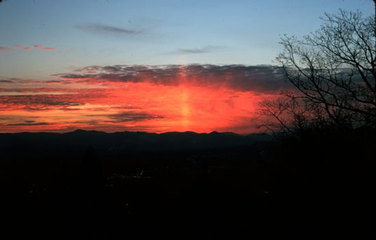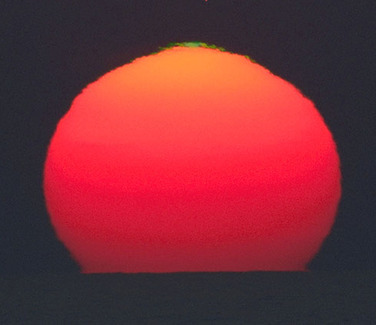Other strange things happen when the sun sets, but you'll need some patience and a lot of luck to spot them.
Solar Pillars
One such striking site is a solar pillar, but again, the sun itself has little to do with the effect, other than providing us with the necessary light.
A pillar is typically rendered in cold air by ice crystals falling from high clouds. The crystals are sometimes flat, and air resistance will cause them to float flatly, rather than falling downward on their edge. Sunlight then reflects off the crystals and generates what appears to be a column of light soaring into space.
The pillar looks like it comes from the sun, but in reality it's just a few miles away.
The Green Flash
The rarest of all these tricks of light is the green flash. You'll recall that we last left you on the beach, gazing out over the Pacific. You're there, of course, only because it is a good place to see this rare and fleeting phenomenon. You need a low horizon with a long view . . . a prairie will suffice, and an airplane will do nicely, too.
The key to the green flash mystery again lies in refraction, along with the fact that the sun's white light is actually made of many colors.
The Earth's atmosphere acts like a prism. Blue is refracted the most. Red light is refracted the least. Green is somewhere in the middle.
At sunset, when refraction is most pronounced, there can actually be three images of the sun—a blue one on top, a green one in the middle, and a red one at the bottom. Each overlaps the others.
So why don't we see a blue flash? Because the blue light is scattered so severely that it doesn't even reach our eye. Once in a while though, and typically for less than a full second, a bit of the green light gets through.
And all the while, as you feel the sand growing cooler and you prepare to bid the sun farewell, red light has the most success traveling unimpeded through all the extra atmosphere in its path, which explains the general color of the sky during your last few moments in Malibu.

